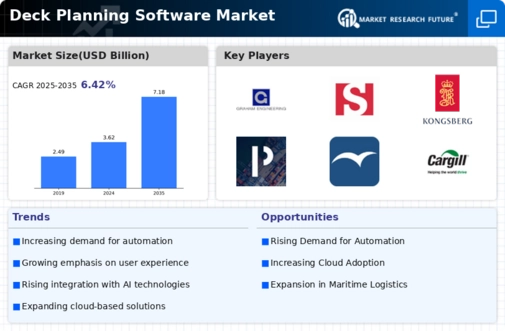Market Growth Projections
The Global Deck Planning Software Market Industry is poised for substantial growth, with projections indicating a market value of 3.62 USD Billion in 2024 and an anticipated increase to 7.18 USD Billion by 2035. This growth trajectory suggests a compound annual growth rate of 6.43% from 2025 to 2035. Such figures underscore the increasing reliance on advanced software solutions across various sectors, particularly in maritime and logistics. The market's expansion reflects broader trends towards digital transformation and the adoption of innovative technologies that enhance operational efficiency and resource management.
Integration of Cloud-Based Solutions
The integration of cloud-based solutions is transforming the Global Deck Planning Software Market Industry. Cloud technology offers scalability, flexibility, and accessibility, allowing organizations to manage their deck planning processes more efficiently. This shift towards cloud-based platforms enables real-time collaboration among teams, regardless of geographical location. As businesses increasingly adopt remote work models, the demand for cloud-based deck planning software is likely to surge. This trend not only enhances operational efficiency but also supports the growing need for data-driven decision-making in dynamic business environments.
Regulatory Compliance and Safety Standards
Regulatory compliance and safety standards significantly influence the Global Deck Planning Software Market Industry. As industries face increasing scrutiny regarding safety protocols, the need for software that ensures adherence to these regulations becomes paramount. Deck planning software assists organizations in maintaining compliance by providing tools for risk assessment and safety management. This is particularly relevant in sectors such as maritime and construction, where safety is critical. The emphasis on compliance is likely to drive market growth, as companies invest in solutions that not only enhance safety but also mitigate potential legal liabilities.
Technological Advancements in Software Solutions
Technological advancements play a pivotal role in the growth of the Global Deck Planning Software Market Industry. Innovations such as artificial intelligence and machine learning are being integrated into deck planning software, enhancing predictive analytics and decision-making capabilities. These technologies allow for real-time data analysis, which is essential for optimizing deck layouts and improving overall efficiency. As organizations seek to leverage these advancements, the market is expected to witness a compound annual growth rate of 6.43% from 2025 to 2035. This growth trajectory indicates a strong inclination towards adopting cutting-edge technologies in deck planning.
Increasing Demand for Efficient Resource Management
The Global Deck Planning Software Market Industry experiences a rising demand for efficient resource management solutions. Companies are increasingly recognizing the importance of optimizing their resources to enhance operational efficiency and reduce costs. For instance, the software enables better allocation of crew and equipment, which is crucial in industries such as shipping and logistics. As a result, the market is projected to reach 3.62 USD Billion in 2024, reflecting a growing trend towards digital transformation in resource management. This shift not only streamlines operations but also contributes to improved decision-making processes within organizations.
Global Expansion of Maritime and Logistics Industries
The global expansion of maritime and logistics industries serves as a key driver for the Global Deck Planning Software Market Industry. As international trade continues to grow, the demand for efficient deck planning solutions becomes increasingly vital. Companies operating in these sectors require software that can optimize vessel space and improve cargo handling processes. This demand is reflected in the projected market growth, with expectations of reaching 7.18 USD Billion by 2035. The expansion of these industries necessitates innovative software solutions that can adapt to the complexities of global logistics and maritime operations.






















Leave a Comment